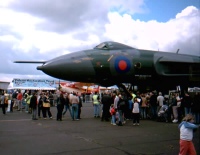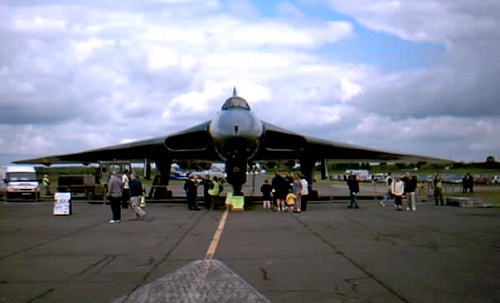
|
Although it's been over ten years since an Avro Vulcan last took to the air, the interest shown in Vulcan XL426 at the end of May 2003 at Southend Airport showed that the airshow-goers' love affair with these giant bombers is far from over! Recent years have seen most of the well deserved headlines devoted to XH558 up in Bruntingthorpe but for those of you who might not have taken any notice up to now, there are other Vulcans in the UK that are still very much alive and well. One such example is XL426, herself an ex-RAF Display ship and now the proud steed of the Vulcan Restoration Trust. On most days of the year this vintage bomber cuts a lonely figure standing on her dispersal pan in a corner of the field but when the gates of the airport are opened to the public this remnant of the once mighty V-Force is mobbed by young and old alike.
 Vulcan XL426 Nose - photo by David Guild
The pedigree of the Vulcan as a pioneering and innovative piece of British engineering is beyond question and you don't need to look any futher than her huge 111ft-wide blended Delta wing to see why people just love the sight of this aircraft. The other aspect of the V-Bomber that draws the people from far and wide of course is the power and sound of her four Rolls Royce powerplants. Besides looking superb, this Cold War warrior has some serious muscle. Sadly, it goes without saying that the nearly 70,000lbs of Olympus thrust can't currently be used to push Vulcans into the sky, but it can be used to push them along the ground and with 5000-odd feet of runway to play with, there's plenty of room for XL426 to make some noise at Southend!
|
 Vulcan XL426 Head-on - photo by David Guild | |
|
At the appointed time, the volunteers from the Vulcan Restoration Trust hand their piece of history over to the aircrew and she's pushed back from the crowd line and one by one the four engines are brought back to life. A Vulcan at idle is a very noisy affair in itself but eventually there's a brief burst of power and the airframe moves off her marks. The noise gives an indication of the ground-shaking power that this bird who turned 40 last year still has in store. While she's taxi-ing slowly around the edge of the airfield, it's possible to witness the spectacle of several hundred camera-wielding Vulcan enthusiasts running from the static area, across a car park and up to the safety barrier of the runway where she's about to arrive. It's quite a distance across that airport but there were some equally determined faces in that stampede! Once 426 is lined up on the centre-line, there's a pause, the engines begin to wind up and the real show begins. I've heard the sound of a Vulcan at full power described in many ways. Aside from the thunderous noise from the back end of the aircraft, there's the awesome sound from the front as well. It's a noise that's hard to describe but it's made by the massive amounts of air being sucked through, and resonating within, the air intakes. I'm not really sure whether it's a 'bellow', a 'howl' or 'an elephantine roar' but whatever you want to call it, there's no other noise like it! Everyone stands and stares. A few seconds later the thrust has done its job and with XL426 blasting down the runway, the throttles are cut, the airbrakes deployed and the drag chute begins to unfurl. It's over...but everyone is still smiling as she taxis back to her static park for a well earned rest.
|
Groups like the Vulcan Restoration Trust keep this facet of our aviation heritage alive and need all the help and support and membership they can get to meet the costs involved. They've got a great website so why not give it a visit and learn a lot more about this example and the Vulcan type in general. XL426 isn't the only ground running Vulcan either. XM655 at Wellesbourne in Warwickshire is an equally impressive creature and her band of supporters are also prone to letting her stretch her legs from time to time. Why not have a look at the 655 Maintenance and Preservation Society website or better still, go along to Wellesbourne on 15th June 2003 and see what you make of her bigger and more powerful 301 engines being put to good use at her Fast-Taxi Run event. Of course to a Vulcan enthusiast, the only thing better than a Vulcan on the ground is a Vulcan in the Sky and if you want to help one get there, take a look at the "Vulcan to the Sky - Save our Heritage" website to see how you can help XH558 win the lottery later this year. If we don't all get behind these projects now, the presence of a Vulcan on a runway, let alone overhead an airshow might really be a thing of the past so if you're interested in the aircraft, act now. Later might be too late.
by David Guild. |
|